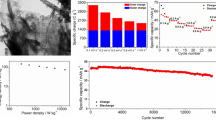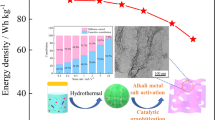Abstract
The development of anode materials with high rate capability and long charge–discharge plateau is the key to improve performance of lithium-ion capacitors (LICs). Herein, the porous graphitic carbon (PGC-1300) derived from a new triply interpenetrated cobalt metal-organic framework (Co-MOF) was prepared through the facile and robust carbonization at 1300°C and washing by HCl solution. The as-prepared PGC-1300 featured an optimized graphitization degree and porous framework, which not only contributes to high plateau capacity (105.0 mAh·g−1 below 0.2 V at 0.05 A·g−1), but also supplies more convenient pathways for ions and increases the rate capability (128.5 mAh·g−1 at 3.2 A·g−1). According to the kinetics analyses, it can be found that diffusion regulated surface induced capacitive process and Li-ions intercalation process are coexisted for lithium-ion storage. Additionally, LIC PGC-1300//AC constructed with pre-lithiated PGC-1300 anode and activated carbon (AC) cathode exhibited an increased energy density of 102.8 Wh·kg−1, a power density of 6017.1 W·kg−1, together with the excellent cyclic stability (91.6% retention after 10000 cycles at 1.0 A·g−1).
Similar content being viewed by others
References
X.L. Yi, X.H. Li, J. Zhong, et al., Unraveling the mechanism of different kinetics performance between ether and carbonate ester electrolytes in hard carbon electrode, Adv. Funct. Mater., 32(2022), No. 48, art. No. 2209523.
C.Y. Wang, T. Liu, X.G. Yang, et al., Fast charging of energydense lithium-ion batteries, Nature, 611(2022), No. 7936, p. 485.
Z.Y. Feng, W.J. Peng, Z.X. Wang, et al., Review of silicon-based alloys for lithium-ion battery anodes, Int. J. Miner. Metall. Mater., 28(2021), No. 10, p. 1549.
X.D. Wang, R.B. Yu, C. Zhan, W. Wang, and X. Liu, Editorial for special issue on advanced energy storage and materials for the 70th Anniversary of USTB, Int. J. Miner. Metall. Mater., 29(2022), No. 5, p. 905.
U. Bhattacharjee, S. Bhowmik, S. Ghosh, and S.K. Martha, Effect of in situ derived sulfur dispersion on dual carbon lithium-ion capacitors, J. Power Sources, 542(2022), art. No. 231768.
S.Y. Dong, N. Lv, Y.L. Wu, G.Y. Zhu, and X.C. Dong, Lithium-ion and sodium-ion hybrid capacitors: From insertion-type materials design to devices construction, Adv. Funct. Mater., 31(2021), No. 21, art. No. 2100455.
P. Naskar, D. Kundu, A. Maiti, P. Chakraborty, B. Biswas, and A. Banerjee, Frontiers in hybrid ion capacitors: A review on advanced materials and emerging devices, ChemElectroChem, 8(2021), No. 8, p. 1390.
J.J. Zhong, L. Qin, J.L. Li, Z. Yang, K. Yang, and M.J. Zhang, MOF-derived molybdenum selenide on Ti3C2Tx with superior capacitive performance for lithium-ion capacitors, Int. J. Miner. Metall. Mater., 29(2022), No. 5, p. 1061.
D. Lei, Z.D. Hou, N. Li, et al., A homologous N/P-codoped carbon strategy to streamline nanostructured MnO/C and carbon toward boosted lithium-ion capacitors, Carbon, 201(2023), p. 260.
G.Y. Zhang, K. Sun, Y.Y. Liu, et al., Double reaction initiated self-assembly process fabricated hard carbon with high power capability for lithium-ion capacitor anodes, Appl. Surf. Sci., 609(2023), art. No. 155083.
Z.W. Yang, H.J. Guo, X.H. Li, et al., Graphitic carbon balanced between high plateau capacity and high rate capability for lithium-ion capacitors, J. Mater. Chem. A, 5(2017), No. 29, p. 15302.
J. Zhang, H.Z. Wu, J. Wang, J.L. Shi, and Z.Q. Shi, Pre-lithiation design and lithium-ion intercalation plateaus utilization of mesocarbon microbeads anode for lithium-ion capacitors, Electrochim. Acta, 182(2015), p. 156.
S.D. Liu, L. Kang, J. Zhang, S.C. Jun, and Y. Yamauchi, Carbonaceous anode materials for non-aqueous sodium- and potassium-ion hybrid capacitors, ACS Energy Lett., 6(2021), No. 11, p. 4127.
M.R. Wu, M.Y. Gao, S.Y. Zhang, et al., High-performance lithium-sulfur battery based on porous N-rich g-C3N4 nanotubes via a self-template method, Int. J. Miner. Metall. Mater., 28(2021), No. 10, p. 1656.
M.Y. Gao, Y.C. Xue, Y.T. Zhang, et al., Growing Co-Ni-Se nanosheets on 3D carbon frameworks as advanced dual functional electrodes for supercapacitors and sodium ion batteries, Inorg. Chem. Front., 9(2022), No. 15, p. 3933.
W. Yang, W. Yang, F. Zhang, G.X. Wang, and G.J. Shao, Hierarchical interconnected expanded graphitic ribbons embedded with amorphous carbon: An advanced carbon nanostructure for superior lithium and sodium storage, Small, 14(2018), No. 39, art. No. 1802221.
M. O’Keeffe and O.M. Yaghi, Deconstructing the crystal structures of metal-organic frameworks and related materials into their underlying nets, Chem. Rev., 112(2012), No. 2, p. 675.
Z.Q. Ye, Y. Jiang, L. Li, F. Wu, and R.J. Chen, Rational design of MOF-based materials for next-generation rechargeable batteries, Nano Micro Lett., 13(2021), No. 1, art. No. 203.
J.W. Zhou and B. Wang, Emerging crystalline porous materials as a multifunctional platform for electrochemical energy storage, Chem. Soc. Rev., 46(2017), No. 22, p. 6927.
S.Y. Zhang, Y.C. Xue, Y.T. Zhang, et al., KOH-assisted aqueous synthesis of bimetallic metal-organic frameworks and their derived selenide composites for efficient lithium storage, Int. J. Miner. Metall. Mater., 30(2023), No. 4, p. 601.
J.N. Zhou, Q.Y. Yang, Q.Y. Xie, et al., Recent progress in Co-based metal-organic framework derivatives for advanced batteries, J. Mater. Sci. Technol., 96(2022), p. 262.
M.X. Liu, F.L. Zhao, D.Z. Zhu, et al., Ultramicroporous carbon nanoparticles derived from metal-organic framework nanoparticles for high-performance supercapacitors, Mater. Chem. Phys., 211(2018), p. 234.
A.D. Tan, Y.F. Wang, Z.Y. Fu, P. Tsiakaras, and Z.X. Liang, Highly effective oxygen reduction reaction electrocatalysis: Nitrogen-doped hierarchically mesoporous carbon derived from interpenetrated nonporous metal-organic frameworks, Appl. Catal. B, 218(2017), p. 260.
Y.C. Xue, X.M. Guo, M.R. Wu, et al., Zephyranthes-like Co2NiSe4 arrays grown on 3D porous carbon frame-work as electrodes for advanced supercapacitors and sodium-ion batteries, Nano Res., 14(2021), No. 10, p. 3598.
H.B. Aiyappa, P. Pachfule, R. Banerjee, and S. Kurungot, Porous carbons from nonporous MOFs: Influence of ligand characteristics on intrinsic properties of end carbon, Cryst. Growth Des., 13(2013), No. 10, p. 4195.
Y.X. Zhao, Y.W. Sun, J. Li, et al., Interpenetrated N-rich MOF derived vesicular N-doped carbon for high performance lithium-ion battery, Dalton Trans., 51(2022), No. 20, p. 7817.
S. Yuan, Q.H. Lai, X. Duan, and Q. Wang, Carbon-based materials as anode materials for lithium-ion batteries and lithiumion capacitors: A review, J. Energy Storage, 61(2023), art. No. 106716.
Y.B. Ma, K. Wang, Y.N. Xu, et al., Dehalogenation produces graphene wrapped carbon cages as fast-kinetics and large-capacity anode for lithium-ion capacitors, Carbon, 202(2023), p. 175.
Z.Y. Li, Y.X. Ye, Z.Z. Yao, et al., An antiferromagnetic metalloring pyrazolate (Pz) framework with [Cu12(μ2-OH)12(Pz)12] nodes for separation of C2H2/CH4 mixture, J. Mater. Chem. A, 6(2018), No. 40, p. 19681.
J.X. Wang, Z.L. Yan, G.C. Yan, et al., Spiral graphene coupling hierarchically porous carbon advances dual-carbon lithiumion capacitor, Energy Storage Mater., 38(2021), p. 528.
Y.Y. Zhu, M.M. Chen, Q. Li, C. Yuan, and C.Y. Wang, A porous biomass-derived anode for high-performance sodium-ion batteries, Carbon, 129(2018), p. 695.
Y. Chen, K.L. Zhang, N. Li, et al., Electrochemically triggered decoupled transport behaviors in intercalated graphite: From energy storage to enhanced electromagnetic applications, Int. J. Miner. Metall. Mater., 30(2023), No. 1, p. 33.
L.Y. Zhao, X.Y. Zhao, L.T. Burke, J.C. Bennett, R.A. Dunlap, and M.N. Obrovac, Voronoi-tessellated graphite produced by low-temperature catalytic graphitization from renewable resources, ChemSusChem, 10(2017), No. 17, p. 3409.
D.P. Qiu, C.H. Kang, M. Li, et al., Biomass-derived mesopore-dominant hierarchical porous carbon enabling ultra-efficient lithium-ion storage, Carbon, 162(2020), p. 595.
S.W. Lee, N. Yabuuchi, B.M. Gallant, et al., High-power lithium batteries from functionalized carbon-nanotube electrodes, Nat. Nanotechnol., 5(2010), No. 7, p. 531.
H.B. Ouyang, Y.Y. Ma, Q.Q. Gong, et al., Tailoring porous structure and graphitic degree of seaweed-derived carbons for high-rate performance lithium-ion batteries, J. Alloys Compd., 823(2020), art. No. 153862.
D.B. Kong, Y. Gao, Z.C. Xiao, X.H. Xu, X.L. Li, and L.J. Zhi, Rational design of carbon-rich materials for energy storage and conversion, Adv. Mater., 31(2019), No. 45, art. No. 1804973.
A. Gomez-Martin, J. Martinez-Fernandez, M. Ruttert, et al., Iron-catalyzed graphitic carbon materials from biomass resources as anodes for lithium-ion batteries, ChemSusChem, 11(2018), No. 16, p. 2776.
D. Adekoya, H. Chen, H.Y. Hoh, et al., Hierarchical Co3O4@N-doped carbon composite as an advanced anode material for ultrastable potassium storage, ACS Nano, 14(2020), No. 4, p. 5027.
K. Tang, X.Q. Yu, J.P. Sun, H. Li, and X.J. Huang, Kinetic analysis on LiFePO4 thin films by CV, GITT, and EIS, Electrochim. Acta, 56(2011), No. 13, p. 4869.
J.M. Jiang, Z.W. Li, Z.T. Zhang, et al., Recent advances and perspectives on prelithiation strategies for lithium-ion capacitors, Rare Met., 41(2022), No. 10, p. 3322.
X.Z. Sun, X. Zhang, W.J. Liu, et al., Electrochemical performances and capacity fading behaviors of activated carbon/hard carbon lithium-ion capacitor, Electrochim. Acta, 235(2017), p. 158.
J.T. Su, Y.J. Wu, C.L. Huang, et al., Nitrogen-doped carbon nanoboxes as high rate capability and long-life anode materials for high-performance Li-ion capacitors, Chem. Eng. J., 396(2020), art. No. 125314.
G. Moreno-Fernández, M. Granados-Moreno, J.L. Gómez-Urbano, and D. Carriazo, Phosphorus-functionalized graphene for lithium-ion capacitors with improved power and cyclability, Batteries Supercaps, 4(2021), No. 3, p. 469.
Z.Q. Shi, J. Zhang, J. Wang, J.L. Shi, and C.Y. Wang, Effect of the capacity design of activated carbon cathode on the electrochemical performance of lithium-ion capacitors, Electrochim. Acta, 153(2015), p. 476.
P. Yu, G.J. Cao, S. Yi, et al., Binder-free 2D titanium carbide (MXene)/carbon nanotube composites for high-performance lithium-ion capacitors, Nanoscale, 10(2018), No. 13, p. 5906.
X. Wang, Z.K. Wang, X. Zhang, et al., Nitrogen-doped defective graphene aerogel as anode for all graphene-based lithiumion capacitor, ChemistrySelect, 2(2017), No. 27, p. 8436.
M.X. Zhang, X. Zhang, Z.X. Liu, H.F. Peng, and G.K. Wang, Ball milling-derived nanostructured Li3VO4 anode with enhanced surface-confined capacitive contribution for lithium-ion capacitors, Ionics, 26(2020), No. 8, p. 4129.
J.G. Ju, L.T. Zhang, H.S. Shi, Z.J. Li, W.M. Kang, and B.W. Cheng, Three-dimensional porous carbon nanofiber loading MoS2 nanoflake-flowerballs as a high-performance anode material for Li-ion capacitor, Appl. Surf. Sci., 484(2019), p. 392.
Acknowledgements
This work was financially supported by the National Natural Science Foundation of China (No. 52004179), the Natural Science Foundation of Guangxi Province, China (No. 2020GXNSFAA159015), Shanxi Water and Wood New Carbon Materials Technology Co., Ltd., China, and Shanxi Wote Haimer New Materials Technology Co., Ltd, China.
Author information
Authors and Affiliations
Corresponding authors
Ethics declarations
All authors declare that they have no financial interests or personal relationships that could have appeared to influence the work reported in this paper.
Supplementary Information
12613_2023_2726_MOESM1_ESM.docx
MOF-derived porous graphitic carbon with optimized plateau capacity and rate capability for high performance lithium-ion capacitors
Rights and permissions
About this article
Cite this article
Chu, G., Wang, C., Yang, Z. et al. MOF-derived porous graphitic carbon with optimized plateau capacity and rate capability for high performance lithium-ion capacitors. Int J Miner Metall Mater 31, 395–404 (2024). https://doi.org/10.1007/s12613-023-2726-2
Received:
Revised:
Accepted:
Published:
Issue Date:
DOI: https://doi.org/10.1007/s12613-023-2726-2




